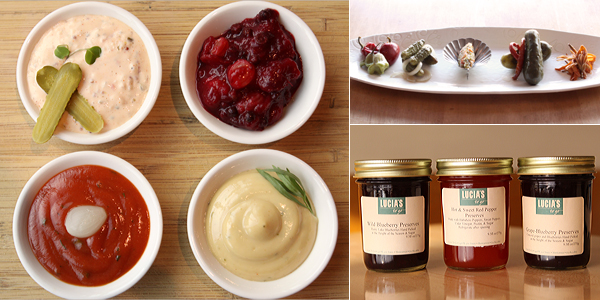
Condiments are, by definition, used to enhance the flavor of a food. Often overlooked but rarely underused, they are staples on nearly every restaurant menu. Although available for purchase, many local restaurants choose to craft their own. Following are three establishments that take scratch-made dishes to heart, all the way down to their condiments.
Pickling at Grand Cafe
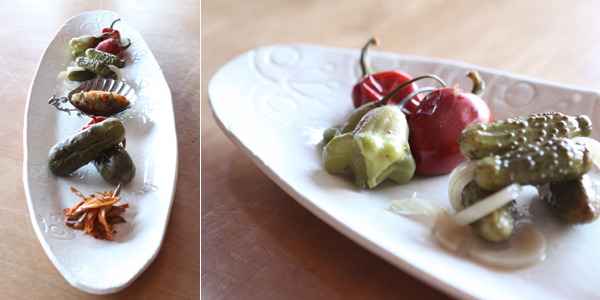
It’s fitting that pickling is used often at Grand Cafe. Sous chef Ben’s last name happens to be Pichler. “As far as our condiments go, it’s probably our biggest,” says Chef Jon Radle. “If we can pickle something, we will.” The preservation method adds an acid or brine to produce in order to lengthen its window of edibility. Because of their long shelf life, pickled condiments allow the restaurant to serve local produce year-round. For example, diners might find ramps (a cross between a garlic bulb and a leek) that are harvested during the spring on their winter menu.
One pickling method Radle and Pichler use incorporates a house-made vinegar made from yarrow (an herb). Another is brining the produce of choice in a salt solution, either hot or cold. Cold brines take longer, but preserve texture and crunch, a key requirement for softer vegetables. Radle and Pichler don’t discriminate when it comes to pickling. They’ve tried everything from beets, to white asparagus, to kohlrabi (a member of the cabbage family). “Growing up, my family canned and pickled things throughout the summer, so when I came here we revamped some of the recipes,” says Pichler.
Currently they offer a spicy pickle relish served on both Smoked Tuna Belly Canapes (available on the menu until they run out), and the Cubanesque (their take on the sandwich, available year-round). Dill pickles are served during lunch alongside sandwiches. Pickled ramps are used in the Duck Confit Salad, and the house-pickled hot peppers (made with young scotch bonnet and cherry bomb peppers) are served with the Laughing Bird Shrimp and Grits appetizer. They have quite the kick, so be prepared.
Preserves at Lucia’s
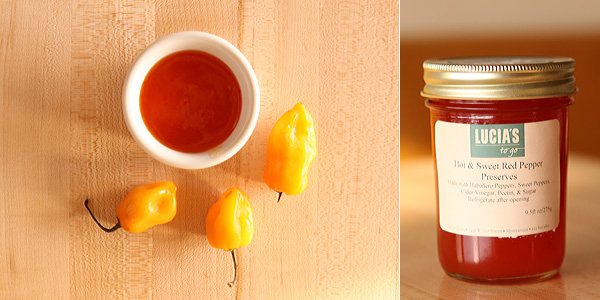
“The Habanero and Sweet Pepper Preserves have always been a staple at Lucia’s,” says Chef Heidi Binglee. The recipe was developed by Susan Dietrich, Binglee’s predecessor. The ingredients are simple: locally grown habanero and sweet peppers, cider vinegar, pectin, and sugar. The first bite — spread on a cube of house-made flax millet bread — was pleasantly cleansing. A shot of heat from the habaneros reveals itself from underneath the sweetness of the other peppers. It’s served on the to-go lunch menu with a vegan three-bean chili. However, rather than serve the the preserves alone, they mix it first with sour cream to make a habanero cream. Binglee also recommends eating it at home by spreading a smear of cream cheese on top of a cracker and topping it with the pepper preserves.
Two additional highlights are the wild blueberry preserves, made with blueberries picked around Rainy Lake in northern Minnesota, and the blueberry grape preserves, made with grapes provided courtesy of Chef / Owner Lucia Watson’s neighbor in Minneapolis. Both are made using only two ingredients, fruit and sugar. (Recommendation: try either with a homemade popover, found on both the to-go side and brunch menu.) Sourcing local fruits is an important virtue at the restaurant. Watson has also been known to use harvested ingredients from her own family. Lucia’s used to sell mint jelly: The mint was picked from Watson’s mother’s garden by her aunt Betty. Jams and preserves are available for purchase on the to-go side ($7 for a 9.5 oz. jar).
Sauces and Chutney at Spoonriver
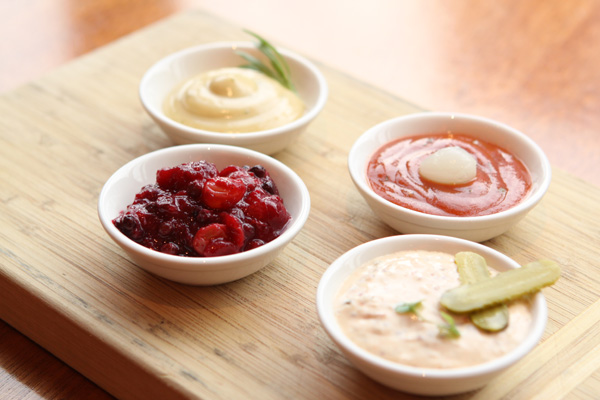
House-made condiments are woven into all three menus at Spoonriver: brunch, lunch, and dinner. Four of the most notable however, are the ketchup, mustard, tartar sauce, and cranberry chutney. Some have been served for years (the cranberry chutney was developed by Chef Liz Benser 18 years ago), while others are newly minted evolutions (the tartar sauce was introduced last year — a joint effort by Chef / Owner Brenda Langton and Benser).
Spoonriver’s mustard sauce is served with one of Langton’s classics, the Wild Mushroom and Pistachio Terrine (brought over from the now closed Cafe Brenda). “It’s emulsified, so it’s smoother and doesn’t
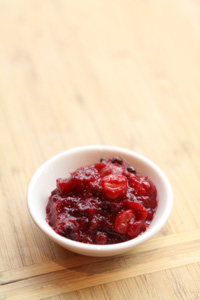
have as strong of a bite as other mustards,” says Benser. They start with a Dijon base, then add rice vinegar, garlic, cayenne, sunflower oil, and, if available, fresh tarragon. The terrine is also served with their cranberry chutney, made with dried fruits and cranberries, diced fresh oranges, apple juice, mustard, ginger, and spices. Often times the chutney is used as a sauce substitute for diners with food allergies or sensitivities.
Their ketchup, served on the Lamb Burger, is spiced up with Dijon, sherry vinegar, worcestershire, chives, tarragon, and olive oil. Compared to other restaurants, Langton prefers to use healthier oils in her sauces. “That’s something we do differently here,” she says. Tartar sauce is made from a base of Mrs. Clark’s Mayonnaise — an Iowa-based product that uses no added sugars or sweeteners – followed by a slew of flavorful additions, including cornichons (pickles made from tiny gherkin cucumbers), capers, mustard, parsley, shallots, garlic, parsley, and tarragon. It’s served on the Mahi Mahi sandwich. One shouldn’t be ashamed to order extra. “For me, the sandwich is really just a vehicle for the tartar sauce,” says Benser.

Well, thanks for letting me know there is a mahi mahi sandwich at Spoonriver. I will have to be trying that soon, with plenty of the tartar sauce. Only thing is, I’ve tasted Mrs. Clark’s mayo and it tastes sweet. So I wonder how they get that without sugar.
The Strip Club in St. Paul makes a lot of this kind of stuff– their pickles are outrageously good, for one… and the mixers they use in their cocktails…. mmmm….